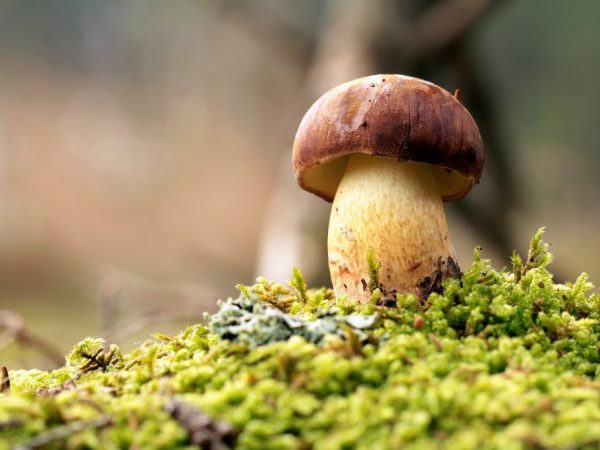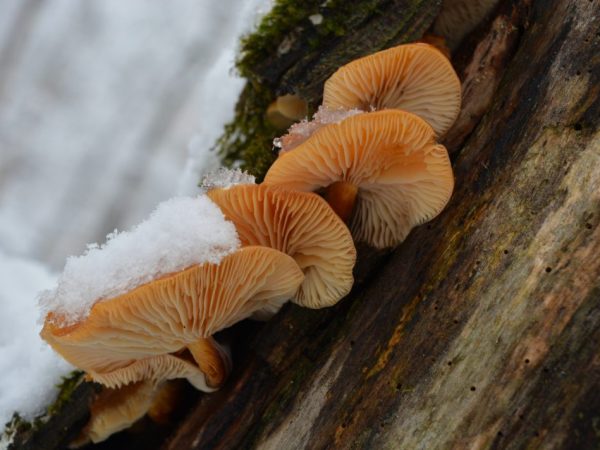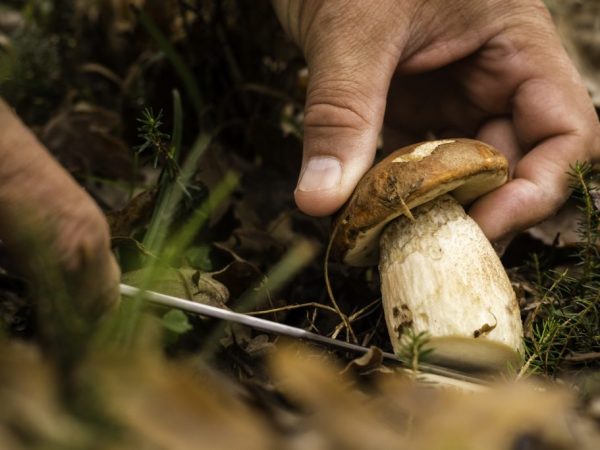What mushrooms grow in October
Autumn is an excellent period for mushroom growth. Mushrooms in October on the territory of the country delight with their diversity and productivity.
- Varieties of mushrooms
- Porcini
- Boletus
- Ryzhik
- Oyster mushroom
- Winter mushrooms
- Row purple
- Smoky talker
- Common garlic
- Pink hair
- Greenfinch
- Common chanterelles
- Orange shiver
- Fucus-shaped shiver, or ice mushroom
- Mushroom places of the country
- Places near Moscow
- Orenburg direction
- Tambov Region
- Voronezh region
- Crimea
- Collection rules
- Conclusion

Mushrooms in October
Varieties of mushrooms
Various mushrooms grow in October. Edibles are harvested in whole baskets, provided that it was raining and there was no frost.
It is easy to find under the leaves in the forest:
- boletus;
- mushrooms;
- flywheels;
- russula.
With the onset of frost in October, mushrooms will grow:
- greenfinches;
- rows.
Porcini
Porcini mushrooms grow in October before the onset of frost. Their cap is dark brown, sometimes with a purple tint, if they grow in the forest around the pines, in spruce it is red-brown or brown, in deciduous it is light.
The pulp is dense, white, the color remains unchanged. Mushrooms are used for pickling, salting, drying, frying.
To date, 18 forms of porcini mushroom have been described, which differ:
- external features of fruiting bodies;
- the season of the appearance of fruit bodies;
- features of the development of mycorrhiza;
- climate features, etc.
Boletus
The name of the mushroom says that it grows under birches, but is more common in deciduous forests, on hillocks, light edges. Boletus boletus are mycorrhiza formers, in fact the name itself indicates a symbiont tree species. The caps of these mushrooms are characterized by a soft brownish color.
These mushrooms belong to the genus Leccinum or Obabok. Outwardly, they are very similar to aspen boletus, from which they differ in some "elegance" of the legs and the density of the pulp in the cap. Their flesh on the cut does not turn blue, in contrast to the boletus. Very often boletus are called "boletus". For these edible mushrooms, there is an inedible counterpart - gall mushroom or bitterness.
Boletus mushrooms are used for salting and drying.
Ryzhik
Ryzhik grows in young pine forests, on forest edges. It has a bright, red-orange hue with dark orange ring zones on the cap, has good taste, and is used for salting. Camelina belongs to category 1 mushrooms.
Irina Selyutina (Biologist):
Ryzhik is a generalized name for a whole group of species from the genus Mlechnik. Mushrooms are distinguished from other representatives of the genus by the presence of a pleasant-tasting milky juice colored in shades of red. The beta-carotene present in the pulp, which is a precursor of vitamin A, gives the mushrooms a "sunny" color. suppress the growth of most bacteria (including tuberculosis).
Please note! Very often, novice mushroom pickers confuse saffron milk caps with pink fluff - a conditionally edible species, less valuable from the point of view of nutritional value.You can distinguish these mushrooms by the white milky juice that does not change its color upon contact with air and the highly pubescent surface of the cap of the wave.
The pulp on the scrap quickly turns red, and then turns green, it does not return to its original color.
Unlike a number of other lamellar mushrooms, camelina does not need to be pre-soaked - it can lead to greening or even blackening of the fruiting body. For mushrooms, cleaning from debris and rinsing under running water will be quite enough.
Oyster mushroom
Oyster mushroom grows in October-November, in periods - until the beginning of winter, normally tolerates cold weather.
Oyster mushrooms are a collective concept and represent a whole family of mushrooms in which there are species cultivated by humans. They belong to the group of wood-destroying saprophytic fungi. They usually grow in groups on stumps, dead wood, as well as dead or living, weakened representatives of deciduous trees and much less often on coniferous trunks. When growing on trunks, they are found high enough above the ground. Fruit bodies grow together at the base forming a kind of "clusters" and as a result form multi-tiered "structures". These mushrooms are the source of yellow mixed rot of deciduous trunks and, occasionally, conifers. In order for an infection to occur on the surface of the trunk, there must be damage - most often this is the so-called. "Frost breakers". Fruit bodies will appear where rot will develop most. The colony will continue to grow on the trunk even after the tree dies.
Oyster mushrooms are used for frying, pickling, salting.
Winter mushrooms

Winter mushrooms are tastier than autumn ones
Winter mushrooms are used for pickling, frying, pickling, they taste better than autumn mushrooms. Winter mushrooms are also called velvety-footed flammulina. The mushroom cap is covered with a small layer of mucus, smooth, honey-colored. The edges are usually lighter than the center. The leg is tubular, dense, without a "skirt". Flammulin grows in colonies. Mushroom pickers often collect some hats, because the legs are quite stiff. Its lower part is cut off even in young mushrooms.
Depending on where flammulina settles, it can be a saprophyte or a parasite. This means that it can grow both on live weakened trees and dead trunks. It can often be found on willows and poplars, which are found along the banks of streams, as well as forest edges, in the territory of settlements (in gardens and parks).
Row purple
Row purple, or naked lepist, is a popular conditionally edible species among lovers of mushroom picking in October. Her bonnet is a conspicuous purple. The fungus tolerates cold weather well, grows until the beginning of winter. The row is pickled, used for frying, pickles. However, it needs preliminary processing - it must be boiled for 15 minutes, and the broth must be drained.
Smoky talker
Smoky talker is a conditionally edible species. This species is characterized by a special feature that makes the representatives of the species recognizable - in young specimens, the edge is very tucked up and this feature persists even when the cap changes from a convex shape to a straightened one. The surface of the cap is painted in ashy color, sometimes with a yellowish tint. As is often the case with mushrooms, the edge of the cap is lighter than the center. Not every human body is able to digest this mushroom without problems. To avoid negative consequences in the form of indigestion, the mushrooms should be boiled and the water drained.
Talkers grow next to the rowing house in October-November. They are salted, fried, pickled.
Common garlic
The garlic plant is characterized by the presence of a garlic aroma. A miniature cap, reaching a diameter of 1-3 cm, is first painted in a yellowish-brown color, and as it grows, it becomes fawn. Convex in young specimens, it becomes flat-spread and even bell-shaped.The hat has the property of hygrophilousness - absorption and retention of moisture, as a result of which its color becomes meat-red, and in dry weather, on the contrary, it becomes faded.
The smell is especially pronounced in damp weather. The dried and powdered mushroom is used as a seasoning. By the way. Sometimes garlic is confused with meadow mushrooms, but they do not smell like garlic.
Pink hair
Volnushka is common in various forests and birch forests. It requires some processing: it must be soaked in water to remove the bitterness. Bitterness is caused by the presence of milky juice in the white, strong and dense pulp. Milky sap is very abundantly formed in the fruit body; it tastes pungent and does not change color upon contact with air. The pink bollard forms mycorrhiza mainly with already old birch trees, therefore it is found in birch and mixed forests with the presence of birches, sometimes in humid places. Grows in groups. By the way. Despite the pungent taste, the mushroom is often attacked by worms.
This mushroom is good for pickling.
Greenfinch
Zelenushka, or green ryadovka, is a conditionally edible species with excellent taste. The mushroom got its interesting name due to the fact that even after heat treatment it retains its green cap. As they grow older, the flat-convex cap with a characteristic tubercle in the center becomes flat-spread. The flesh of a young mushroom is dense and white, while in older specimens it is yellowish. The smell is flour, but the taste is not pronounced.
Irina Selyutina (Biologist):
The green row forms ectomycorrhiza with conifers. The term "ectomycorrhiza" means that the fungal hyphae are located on the root surface, forming a kind of cover and do not penetrate into the root cells. You can find this type of rowing in dry pine forests on sandy soils, which requires mandatory washing of the mushrooms to remove sand both from the surface of the cap and from the hymenophore plates under the cap. During growth, it can form groups of 5-8 specimens. In pine forests (in open areas), it can be found even at a time when other edible species have already "departed".
The period of active fruiting of the green row falls in September-November, up to frost.
Common chanterelles
Chanterelles never damage worms. This feature is associated with the presence in the fruiting body of a natural compound of quinomannose, which has a destructive effect both on the parasites (worms) themselves and on the egg clutch.
It is also interesting that these mushrooms have a very different hymenophore outwardly. We used to think of it as lamellar, but in fact, its exact name is folded. The plates and folds are very different in appearance from each other. In addition, chanterelles lack a clearly defined border between the cap and the leg. The folds of the hymenophore smoothly descend to the upper part of the leg (descend), blurring this border.
It will be easy to pick mushrooms in October: the chanterelles are clearly visible under the leaves due to their color.
For your information. For chanterelles there is a double - a false chanterelle, or orange talker, which is found in coniferous and mixed forests until the end of October.
Orange shiver
The orange tremor has a bright orange tint, a delicate jelly consistency of the fruit body, consisting of blades - smooth, shiny and sinuous. Gelatinous, or jelly-like pulp has no smell or taste. Soups and omelets are prepared with it. However, on the territory of Russia, this type of nutritional value does not have, because. our mushroom pickers are not interested in it because of the peculiarities associated with transportation and preparation.
Fucus-shaped shiver, or ice mushroom
The ice mushroom is characterized by a jelly, but rather dense consistency of the fruiting body. Its body consists of rather graceful petals, almost transparent in color, with a slight whiteness. Dimensions are 4 cm high and about 7-8 cm across.The mushroom belongs to the group of edible mushrooms, for which preliminary boiling for 5-7 minutes is recommended or, if desired, steaming for 7-10 minutes, which gives an increase in the volume of the fertile body by about 4 times.
An ice mushroom on the territory of the Russian Federation was recorded only in Primorye.
Mushroom places of the country
Autumn mushrooms are collected in many areas of the country.
Places near Moscow
Boletus, chanterelles, boletus grow along the Savelovsky direction. It covers the areas around Ozeretsky, Fedoskino, Sholokhov.
A pine forest is located in the Kazan direction around the Chornaya station. Butterlets and chanterelles are not advised to collect here: they absorb toxic compounds and salts of heavy metals from the environment.
A mixed forest is located along the Leningrad direction in the areas of Firsanovka, Nazaryevo, the village of Elino, Leningradskoye highway. Honey mushrooms, porcini mushrooms, mushrooms grow in it. In early and late October, mushrooms have different yields.
Orenburg direction

Orenburg region is rich in mushrooms
Many edible species grow in Orenburg and in the region. Mushrooms of this direction can be harvested from late October to November. It:
- porcini;
- mushrooms;
- milk mushrooms;
- boletus;
- honey agarics;
- boletus;
- chanterelles;
- Champignon;
- oyster mushrooms.
Tambov Region
In the Tambov region there are forests rich in berries, medicinal herbs and mushrooms. In autumn these places abound in different types of mushrooms, here you can find:
- boletus;
- goats;
- White mushrooms;
- flywheels;
- boletus;
- aspen mushrooms;
- milk mushrooms;
- chanterelles;
- Polish mushrooms;
- mushrooms;
- poplar rows;
- honey agarics;
- russula.
Voronezh region
The following edible mushrooms will grow in the Voronezh Region in October:
- oyster mushroom;
- talker;
- oak tree;
- winter mushroom (flammulina velvety-footed);
- lump;
- wave;
- porcini;
- chestnut mushroom;
- chanterelle;
- mushroom;
- may mushroom;
- oiler;
- flywheel;
- boletus;
- boletus;
- champignon;
- saffron milk cap.
Crimea
Crimea in autumn is rich in edible species. On the peninsula in October you can find:
- chanterelles;
- mushrooms;
- mountain white mushroom (giant talker);
- "Mice" or rows are gray;
- raincoats;
- boletus.
Collection rules
Gathering mushrooms should be done carefully. It is important to distinguish between edible and poisonous species. If you are not sure of the correctness of your choice, pass by. Likewise, do not touch the overgrown edible mushrooms - decomposition processes have begun in them, because the main "life goal" of the fruiting body is not to become the prey of the mushroom picker, but to form and spread spores. Help the mushroom with this by placing it on a branch so the spores can be carried long distances by the wind.
When setting a festive table with mushroom snacks, do not forget that some types of edible mushrooms in combination with alcoholic beverages cause severe poisoning.
After collecting, the mushroom must be checked. If there is suspicion of toxicity, the product should not be consumed.
Conclusion
October is considered the peak of mushroom growth. A preliminary study of the species allows you to collect edible options and use them to prepare meals and preparations for the winter.



